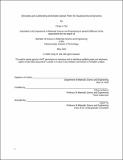| dc.contributor.author | Shi, Cindy H. | en_US |
| dc.contributor.other | Massachusetts Institute of Technology. Department of Materials Science and Engineering. | en_US |
| dc.date.accessioned | 2021-10-08T16:47:54Z | |
| dc.date.available | 2021-10-08T16:47:54Z | |
| dc.date.copyright | 2020 | en_US |
| dc.date.issued | 2020 | en_US |
| dc.identifier.uri | https://hdl.handle.net/1721.1/132795 | |
| dc.description | Thesis: S.B., Massachusetts Institute of Technology, Department of Materials Science and Engineering, May, 2020 | en_US |
| dc.description | Cataloged from the official PDF version of thesis. | en_US |
| dc.description | Includes bibliographical references (page 30). | en_US |
| dc.description.abstract | Study of the central nervous system (CNS) in freely-moving animal behavior experiments is greatly limited by the materials available for neural probing and optical recording, such as silica, which are stiff and can damage neural tissue with vigorous test subject movement. In this work, we develop a polyvinyl alcohol (PVA) hydrogel optical fiber for photometric recording of neural dynamics that is flexible and stretchable, leading to minimal harm to surrounding brain tissue. The hydrogel fiber fabrication method is optimized for highest refractive index and lowest autofluorescence for best signal recording precision, and further customized to allow chemical delivery to the fiber implantation site via either payload adsorption and diffusion through a porous outer layer of the fiber or an embedded polytetrafluoroethylene (PTFE) fluidic channel along the side of the PVA hydrogel. Absorption swelling and kinetics of the nonporous and porous fibers are characterized experimentally and backed by theoretical analysis. PVA-PTFE composite fiber curling during drying due to mismatched material swelling behavior is also theoretically modelled to determine the constraining force needed to keep the fiber straight for better surgical precision, and a fiber straightening device is designed for this purpose. To demonstrate the optical recording capability of this flexible fiber, the nonporous PVA hydrogel is implanted into the ventral tegmental area of the mouse deep brain, along with a viral injection containing fluorescence-expressing gene GCaMP6s, mouse social behavior tests with simultaneous photometry recording are conducted up to 2 months after implantation, and resulting photometric curve amplitudes are analyzed to distinguish between neural activity during social and nonsocial interaction. | en_US |
| dc.description.statementofresponsibility | by Cindy H. Shi. | en_US |
| dc.format.extent | 30 pages | en_US |
| dc.language.iso | eng | en_US |
| dc.publisher | Massachusetts Institute of Technology | en_US |
| dc.rights | MIT theses may be protected by copyright. Please reuse MIT thesis content according to the MIT Libraries Permissions Policy, which is available through the URL provided. | en_US |
| dc.rights.uri | http://dspace.mit.edu/handle/1721.1/7582 | en_US |
| dc.subject | Materials Science and Engineering. | en_US |
| dc.title | Simulating and calibrating stretchable optical fibers for studying neural dynamics | en_US |
| dc.type | Thesis | en_US |
| dc.description.degree | S.B. | en_US |
| dc.contributor.department | Massachusetts Institute of Technology. Department of Materials Science and Engineering | en_US |
| dc.identifier.oclc | 1262873500 | en_US |
| dc.description.collection | S.B. Massachusetts Institute of Technology, Department of Materials Science and Engineering | en_US |
| dspace.imported | 2021-10-08T16:47:54Z | en_US |
| mit.thesis.degree | Bachelor | en_US |
| mit.thesis.department | MatSci | en_US |
